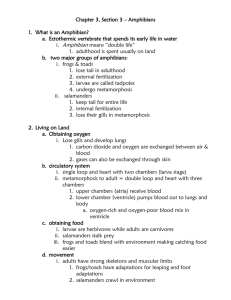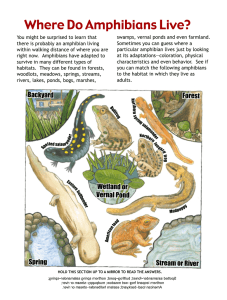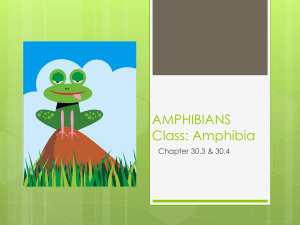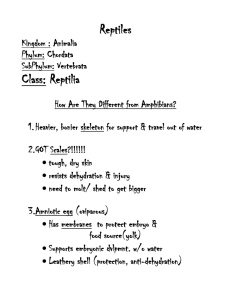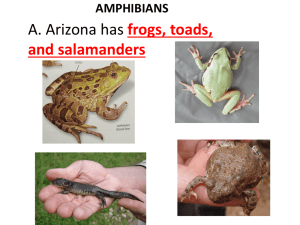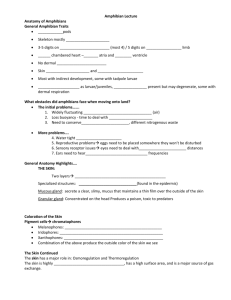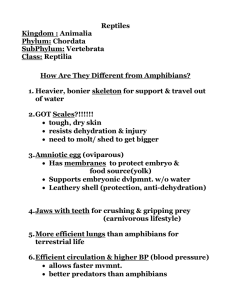COURSE CODE: FWM 312 COURSE TITLE: HERPETOLOGY: AMPHIBIANS
advertisement
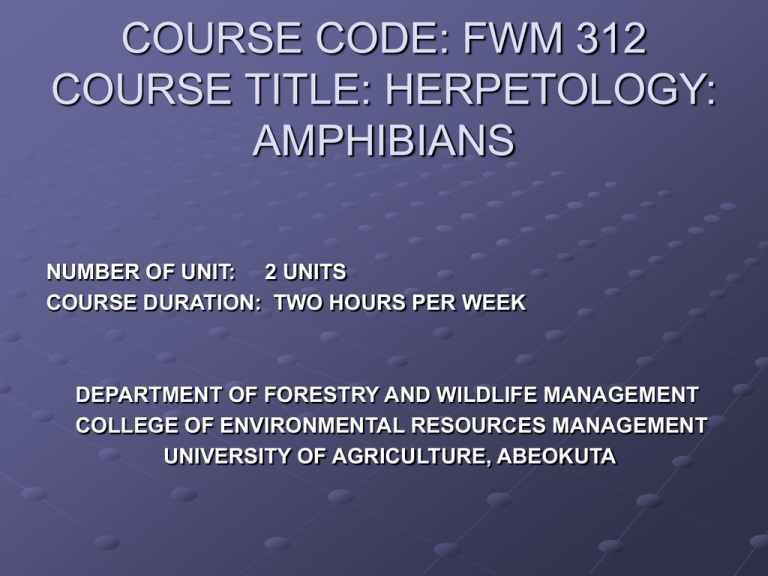
COURSE CODE: FWM 312 COURSE TITLE: HERPETOLOGY: AMPHIBIANS NUMBER OF UNIT: 2 UNITS COURSE DURATION: TWO HOURS PER WEEK DEPARTMENT OF FORESTRY AND WILDLIFE MANAGEMENT COLLEGE OF ENVIRONMENTAL RESOURCES MANAGEMENT UNIVERSITY OF AGRICULTURE, ABEOKUTA COURSE COODINATOR: DR O.A. AKINTUNDE E-mail: osunsinaisrael@yahoo.com Office Location: E 211, COLERM OTHER LECTURERS: DR I.O.O. OSUNSINA DR M. O. O. OYATOGUN TAXONOMIC ARANGEEMNT OF LIVING AMPHIBIANS Class Amphibian Subclass Lissamphibia Order Urodela (tailed amphibians: Salamanders) Family Crytobranchidae (hellbenders) Ambystomatidae (mole salamanders) Salamandridae (newts) Proteidae (mudpuppies and oims) Plethodoritidae (lungless salamanders) COURSE CONTENT Classification and characteristics of important West African reptiles. Anatomy, physiology and reproduction of African reptiles. Food and feeding habits. Distribution and economic importance. COURSE REQUIREMENT This is a compulsory course for all students in Department of Forestry and Wildlife Management. In view of this, students are expected to participate in all the course activities and have minimum of 75% attendance to be able to write the final examination. TAXONOMIC ARANGEEMNT OF LIVING AMPHIBIANS Order Anura (tailess amphibians: frogs and toads) Ranidae Family Ramidae (true frogs) Pipidae (aquatic frogs in Africa) Bufonidae (true toads) Pelobatidae (spadefoo toads) Hylidae (tree frogs) Rhacophoidae (Asian tree frogs) Leptodactylidae (terrestrial, aquatic or arboreal frogs) Order Apoda (legless amphibians: (Caecilians) General features There are 4000 or ore amphibian species. The 4000 amphibians are divided very unequally into three orders. These are the Anura (the Sahelian), the tailless amphibians or frogs and toads are by far the largest group with some 3500 species, the Urodela (or Caudata), tailed amphibians or newts and salamanders with 350 species and Gymnophiona (Apoda), worm-like burrowing Caeciallan with over 150 known species. Common amphibians’ characteristics include shell-less eggs and a naked ore or less permeable skin richly endowed with secretory glands but without scales, fur or feathers. General features Most amphibians therefore require high levels of humidity, or a fully aquatic environment, in which to live. Some can be found which have adapted to condition as dry as the desert e.g. South American leaf frog Phyllomedusa bicolor produces a waxy secretion which spreads genera of spade foot toads spends much of their lives in damp burrows below ground in arid habitats and desert frogs retire underground to produce temporary, impermeable cocoons that tide them over until rains come again. General features Fertilization may be internal or external but with the exception of caecilans the others have no proper intromissive organs and other methods of sperm transfer are employed. Despite their name, amphibians are amphibious only in fresh or mildly saline water, no species can survive prolonged exposure to sea-water. Amphibians do not drink, but absorb the water they need directly through their skins during immersion in ponds or streams. FOOD AND FEEDING Amphibians are almost without exception carnivorous in the adult state. Vegetables matter is rarely found amphibian guts. Anything that is small enough to be swallowed is likely to be taken as prey, those capable of delivering a deterrent bite or sting. The major prey items of amphibians are invertebrates, especially insects, crustaceans, worms and molluscs, but larger, vertebrate organisms are sometimes taken by the bigger species. DEFENCE Amphibians are poorly endowed with tooth and claw. More usual adaptations include Heavy reliance through cryptic coloration, or not being detected in the first place. Rapid flight by leaping or powerful swimming or both sometimes accompanied by alarm calls. Feigning death Adoption of characteristics defence postures including the so called ‘unken and reflex’. This is stationary display adopted by anurans and urodeles bearing aposematic coloration, in an attempt to show their warning signals to the best advantage. Simple defence postures involve hyperinflation with air and body tilting to present a larger-than life image to would be predators such as snakes that can be influenced by their perception prey size. SENSORY SYSTEMS AND LEARNING ABILITIES Eyes are will developed in anurans and most urodeles but degenerates in some salamanders and burrowing caecilians. Vision is critical in prey capture for most anurans and many urodeles and is particularly keen for detecting movement. Although each species has its particular optimum light intensity for visual acuity may are especially adopt at low light levels. Tadpoles and some adult amphibians especially highly aquatic ones also have lateral line detector organs along the sides of the trunk and on the head, similar to those widely occurring in fish. They are sensitive to water currents and play a role in breeding behaviour during displays in which males create such currents and direct them towards females by tail action. REPRODUCTIVE STRATEGIES In urodeles, fertilization is usually internal but there are exceptions with males of the entire aquatic Asiatic salamanders (hynobiidae), giant salamanders (cryptobranchidae) shedding sperm over eggs after they are deposited. Some urodeles with internal fertilization lay their eggs in water and the larvae develop in the same medium e.g. European newts. Others lay their eggs on land and the hatch into aquatic larvae after flooding of the nest site e.g. ambystoma species or may developed completely in the nest without ever entering water e.g. plethodontois Desmognathus aeneus. REPRODUCTIVE STRATEGIES Tiger salamander can produce more than 5, 000 eggs in one season while others species lay just a few hundreds eggs each year. At the other extreme, live bearing terrestrial species e.g. salamandra atra produce one or two young. Parental care also occurs among urodeles, either sex of some fully aquatic salamanders attends to the eggs and appears both to defend and oxygenate them, and females of some species that ovipost in terrestrial nests remain there until hatch time. Commonest mode of anuran reproduction follows the classic pattern of egg deposition and larval development in lotic or lentic fresh waters, although there are variations. REPRODUCTIVE STRATEGIES The deposition of eggs in the small water volumes of tropical plants (bromelids) Another is the production of eggs with sufficient yolk to see the larvae through the metamorphosis without any need to feed. Some lay egg on land which hatch into larvae that fall or crawl into nearly freshwater REPRODUCTIVE STRATEGIES Numerous tropical species make foam nests in which tadpoles hatch either in trees overhanging water or on a bank next to it and form which they gain access to the water for normal larval development. About 10% of known anurans species exhibit some form of care and this can be performed by males or females such as the driving off of potential avian predators some carry eggs or tadpoles around with them. Pipa species, the eggs develop into tadpoles which implanted in the mother’s back and then escape into the water. Male European midwife toads carry eggs entwined around their legs and release tadpoles into ponds when the eggs hatch Some frogs carry tadpoles eggs in a dorsal pouch until hatch time. Gastric brooding frogs (Rheobatrachus species) of Australia, the eggs are swallowed by the female, tadpoles develop in her stomach during an enforced fast and are finally regurgitated after metamorphosis as fully formed frog lets AMPHIBIANS AS HARBINGERS OF DOOM Oven the past few years, amphibians have attracted attention as subjects of study. The prospect of a Global Amphibian Decline (GAD) proposed at the First World Congress of Herpetology held in Britain in 1989. Following a crisis meeting in the United State in 1990, a Declining Amphibian Task Force (DAPTF) was set up in 1991 under the auspices of the International Union for the conservation of Nature and Natural Resources (IUCN) to investigate the matter and recommended any necessary action. AMPHIBIANS AS HARBINGERS OF DOOM The central hypothesis of GAD is that amphibians are especially susceptible to environmental change and should therefore receive particular attention with respect to both study and conservation. Two features of amphibians biology have been widely cited as underpinning this hypothesis; firstly, their typically naked and permeable skins may make them highly vulnerable to chemical pollutants and radiation and secondly, the lifestyle of many species requiring both aquatic and terrestrial habitats to be maintained in suitable conditions. Cause of global amphibian declines AMPHIBIANS AS HARBINGERS OF DOOM Simple causes – The tadpoles of frog are highly susceptible to fish predation. Disease – There can be little doubt that the proximal cause of large-scale amphibian deaths in several situations has been infection with fungal, bacterial or viral pathogens. Diseases are dramatic and their results are easily seen when amphibian populations are large and usually occur on this scale only under stressrelated circumstances that compromise immune systems. AMPHIBIANS AS HARBINGERS OF DOOM Environmental deterioration – There are several ways in which changes in the quality of their environment could affect amphibians. Pesticides constitute perhaps the best known e.g. DDT and its breakdown product DDE are highly persistent. Acidification of groundwater by atmospheric pollutants especially sulfurs dioxide dissolving in rain. Another problem receiving increasing attention is the damage to catalytic chemical especially chlorofluorocarbon (CFCs), released from industrial processes resulting in ozone holes permitting greater amounts of solar radiation especially highly energy ultraviolet (UV) range to reach the earth’s surface. SEXUAL SELECTION IN ANURANS There are two important general mating system of anurans Male frogs and toads invariably grasp females in an amplexus embrace which may last from seconds to many weeks prior to oviposition. Male anurans usually employ vocalization during their breeding seasons And there are three types of breeding behaviours found among the anura. SEXUAL SELECTION IN ANURANS Explosive breeding with all reproduction being completed in a fairly short time period (often less than two weeks). Species using this system often do so in response to environmental cues such as heavy rains in the tropics. Protracted breeding, with activity spread over several months. SEXUAL SELECTION IN ANURANS Protracted breed accompanied by male parent care. Hundreds or thousands of adult toad descend upon their chosen breeding ponds and engage in frantic bouts of mating and spawning that continue day and might but which are often all over within a couple of weeks. In typically explosive breeding pattern there is furious scramble competition between males for females. Largest females are the most fecund and only a small proportion (20%) of males will obtain a female at all. Unpaired males toads constantly search the area around the spawning site, both in the water and on land, looking either for single females or perhaps for females bearing small males that could be displayed. A high proportion (often 80-90%) of common toad females are amplexed before they reach the water’s edge and substantial numbers are drowned by the combined assaults of multiple males.
